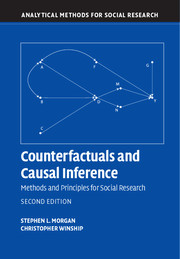Book contents
- Frontmatter
- Dedication
- Contents
- List of Figures
- List of Tables
- Acknowledgments for First Edition
- Acknowledgments for Second Edition
- I Causality and Empirical Research in the Social Sciences
- II Counterfactuals, Potential Outcomes, and Causal Graphs
- III Estimating Causal Effects by Conditioning on Observed Variables to Block Back-Door Paths
- IV Estimating Causal Effects When Back-Door Conditioning Is Ineffective
- 8 Self-Selection, Heterogeneity, and Causal Graphs
- 9 Instrumental Variable Estimators of Causal Effects
- 10 Mechanisms and Causal Explanation
- 11 Repeated Observations and the Estimation of Causal Effects
- V Estimation When Causal Effects Are Not Point-Identified by Observables
- VI Conclusions
- References
- Index
10 - Mechanisms and Causal Explanation
Published online by Cambridge University Press: 05 December 2014
- Frontmatter
- Dedication
- Contents
- List of Figures
- List of Tables
- Acknowledgments for First Edition
- Acknowledgments for Second Edition
- I Causality and Empirical Research in the Social Sciences
- II Counterfactuals, Potential Outcomes, and Causal Graphs
- III Estimating Causal Effects by Conditioning on Observed Variables to Block Back-Door Paths
- IV Estimating Causal Effects When Back-Door Conditioning Is Ineffective
- 8 Self-Selection, Heterogeneity, and Causal Graphs
- 9 Instrumental Variable Estimators of Causal Effects
- 10 Mechanisms and Causal Explanation
- 11 Repeated Observations and the Estimation of Causal Effects
- V Estimation When Causal Effects Are Not Point-Identified by Observables
- VI Conclusions
- References
- Index
Summary
Social scientists have recognized for decades that the best explanations for how causes bring about their effects must specify in empirically verifiable ways the causal pathways between causes and their outcomes. This valuation of depth of causal explanation applies to the counterfactual tradition as well. Accordingly, it is widely recognized that a consistent estimate of a counterfactually defined causal effect of D on Y may not qualify as a sufficiently deep causal account of how D effects Y, based on the standards that prevail in a particular field of study.
In this chapter, we first discuss the dangers of insufficiently deep explanations of causal effects, reconsidering the weak explanatory power of some of the natural experiments discussed already in Chapter 9. We then consider the older literature on intervening variables in the social sciences as a way to introduce the mechanism-based estimation strategy proposed by Pearl (2009). In some respects, Pearl's approach is completely new, and it shows in a novel and sophisticated way how intervening variables can be used to identify causal effects, even when unblocked back-door paths between a causal variable and an outcome variable are present. In other respects, however, Pearl's approach is refreshingly familiar, as it helps to clarify the appropriate usage of intervening variables when attempting to deepen the explanation of a causal claim.
Independent of Pearl's important work, a diverse group of social scientists has appealed recently for the importance of mechanisms to all explanation in social science research.
- Type
- Chapter
- Information
- Counterfactuals and Causal InferenceMethods and Principles for Social Research, pp. 325 - 353Publisher: Cambridge University PressPrint publication year: 2014



